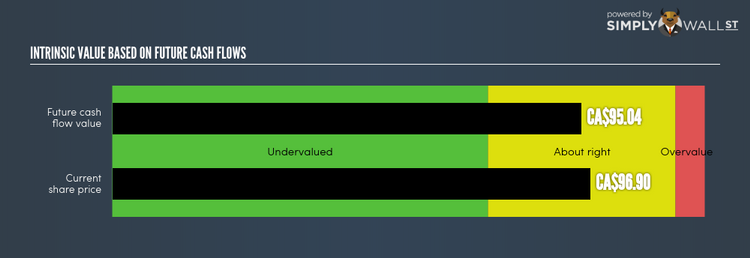Is Intact Financial Corporation (TSE:IFC) Worth $96.9 Based On Intrinsic Value?

Pricing insurance stocks such as IFC is particularly challenging. Given that these companies adhere to a different set of rules relative to other companies, their cash flows should also be valued differently. Industry-specific factors, such as gross written premiums are crucial in understanding how insurance companies make money. Examining elements like book values, as well as the return and cost of equity, can be suitable for assessing IFC’s valuation. Below we’ll take a look at how to value IFC in a fairly effective and easy method. View our latest analysis for Intact Financial
What Model Should You Use?
Let’s keep in mind two things – regulation and type of assets. The regulatory environment in Canada is fairly rigorous. In addition, insurance companies tend to not have significant portions of tangible assets on their balance sheet. While traditional DCF models emphasize on inputs such as capital expenditure and depreciation, which is less useful for a financial stock, the Excess Return model focuses on book values and stable earnings.
The Calculation
The key assumption for Excess Returns is, the value of the company is how much money it can generate from its current level of equity capital, in excess of the cost of that capital. The returns in excess of cost of equity is called excess returns:
Excess Return Per Share = (Stable Return On Equity – Cost Of Equity) (Book Value Of Equity Per Share)
= (13.11% – 8.43%) * CA$54.47 = CA$2.55
We use this value to calculate the terminal value of the company, which is how much we expect the company to continue to earn every year, forever. This is a common component of discounted cash flow models:
Terminal Value Per Share = Excess Return Per Share / (Cost of Equity – Expected Growth Rate)
= CA$2.55 / (8.43% – 2.13%) = CA$40.57
Putting this all together, we get the value of IFC’s share:
Value Per Share = Book Value of Equity Per Share + Terminal Value Per Share
= CA$54.47 + CA$40.57 = CA$95.04
Relative to the present share price of CA$96.9, IFC is , at this time, trading in-line with its true value. This means there’s no real upside in buying IFC at its current price. Pricing is one part of the analysis of your potential investment in IFC. Analyzing fundamental factors are equally important when it comes to determining if IFC has a place in your holdings.
Next Steps:
For insurance companies, there are three key aspects you should look at:
Financial health: Does it have a healthy balance sheet? Take a look at our free bank analysis with six simple checks on things like leverage and risk.
Future earnings: What does the market think of IFC going forward? Our analyst growth expectation chart helps visualize IFC’s growth potential over the upcoming years.
Dividends: Most people buy financial stocks for their healthy and stable dividends. Check out whether IFC is a dividend Rockstar with our historical and future dividend analysis.
For more details and sources, take a look at our full calculation on IFC here.
To help readers see pass the short term volatility of the financial market, we aim to bring you a long-term focused research analysis purely driven by fundamental data. Note that our analysis does not factor in the latest price sensitive company announcements.
The author is an independent contributor and at the time of publication had no position in the stocks mentioned.

